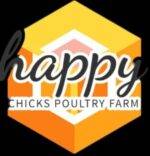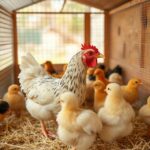“Chick Starter Kit: Essential Tips for Raising Happy and Healthy Chicks!”
Are you ready to embark on your journey as a poultry farmer, but unsure how to give your new chicks the best start in life?
HERE IS A STARTER GUIDE ON HOW TO START ND GROW INTO POULTRY FARMING
Farming is all about learning and being able to sustain yourself while enjoying working on the wonders of God’s creation.
Chick Care for Beginners: Many new poultry farmers struggle with the basics of chick care, including feeding, brooding, and health management. Sustainable Poultry Practices: There’s a growing interest in eco-friendly farming methods, yet detailed guides on sustainable practices for raising chickens are limited.
In order to ensure that improved Kienyeji chicks develop into healthy, productive birds, it is necessary to provide them with the right housing, food, health care, and general attention. In comparison to conventional indigenous chickens, improved Kienyeji chickens, such as breeds like KARI Improved, Kuroiler, Kenbro, and Rainbow Rooster, are hybrids created to improve features including faster growth, higher egg production, and better disease resistance.
Here are some educational resources to help you with their upkeep:
Environment and Housing
Shelter Design: In a semi-free-range system, provide a spacious, predator-proof coop with enough ventilation, around 1 square foot for chicks and 3–4 square feet for adults. To keep it dry and clean, use deep litter (such as wood shavings) or wire mesh flooring.
Temperature Control: Keep day-old chicks’ brooding temperature between 32 and 35°C for the first week, then lower it by 3°C per week until they no longer require extra heat, which should happen in three to four weeks. When necessary, use charcoal burners or heat lamps.
Protection: Make sure the coop is shut off from inclement weather and predators like dogs and hawks. To promote laying and lessen egg breakage, use nesting boxes (for layers) and perches coated with soft materials like sawdust.
Nutrition and Feeding
Starter Phase (0–8 Weeks): To promote quick development, feed chicks a high-protein (18–20%) chick starter mash. Commercial chick mash or a handmade mixture of fish meal, soybean meal, and crushed maize are two examples.
Grower Phase (9–20 Weeks): To increase body bulk without gaining too much fat, switch to grower mash with 16–18% protein. Add more greens, grains (such millet or sorghum), or, if the animal is free-ranging, kitchen leftovers.
Layer Phase (20+ Weeks): If raised for eggs, switch to layer mash (16–18% protein) enhanced with calcium (such as oyster shells) for robust eggshells. To attain market weight (1.5–3.5 kg, depending on breed) in 3–5 months, meat birds should be fed a healthy diet.
Water: Always give chicks fresh, clean water since they need it to be hydrated and digest their food. Add multivitamins at stressful times (e.g., following vaccination) and change it twice a day.
Grit: If they forage, give them little stones or grit separately to help with digestion.
Management of Health
immunization: Adhere to a rigorous immunization regimen.
Day 1: Subcutaneous injection for Marek’s illness.
Day 7 and 28: Infectious bronchitis (IB) and Newcastle disease (NCD) by drinking water.
Day 14 and 21Gumboro (Infectious Bursal Disease) from drinking water
Day 35: NCD+IB again.
Week 8: Fowl typhoid, assuming it’s common where you live.
For local disease risks and appropriate management, see a veterinarian.
Biosecurity: To prevent the transmission of disease, keep the coop clean, cleanse it before adding new chicks, and restrict who visits. Isolate and remove unhealthy birds right away.
Control of Parasites: Use veterinarian-approved medicines to deworm every two to three months after eight weeks and dust or spray for external parasites (such as mites).
Early Care and Brooding
Brooding Setup: Set up the brooder with fresh bedding, heat, and tiny feeders/drinkers (one tray for every 100 chicks) six to twelve hours before the chicks arrive. To promote eating, first sprinkle the feed on the paper.
Monitoring: Every day, look for indications of distress in the chicks, such as huddles or loud chirping. To increase survival rates (preferably 95%+), strive for a homogenous flock and pay special attention to smaller or weaker chicks.
Light: If raising layers, provide 24 hours of light for the first week to promote eating, then cut it down to 16 hours after 4-5 months.
Productivity and Growth
Meat Birds: With the right diet, breeds such as Kuroiler and Kenbro may grow to weigh 1.5–3.5 kg in 3–5 months. Although free-ranging lowers expenses, it may inhibit growth; for quicker results, add commercial feed.
Layers: Breeds such as KARI Improved lay 200–270 eggs annually, with egg production beginning at 5–6 months. For optimal results, maintain regular light (16 hours per day) and nutrition.
Keeping Records: To identify problems early and enhance management, keep track of food intake, weight growth, and health occurrences.
Money-Saving Advice
Foraging: To save feed expenses, let the chicks to free-range under supervision after four weeks. Better Kienyeji chicks are resilient foragers who consume worms, insects, and plants.
Homemade Feeds: For complete nutrition, combine regional foods (such as fish meal, sunflower seeds, and maize) with premixes; ask a nutritionist for the precise ratios.
Hygiene: Maintaining cleanliness lowers illness and veterinary expenses.
You may produce healthier, enhanced Kienyeji chicks with low losses and high returns—whether for meat or eggs—by concentrating on these areas. For optimal results, always adjust procedures to the environment, available resources, and demands of your local market.
“To sum up, for a novice chicken farmer, raising chicks might be one of the most fulfilling experiences. You can make sure that your chicks develop into healthy, productive hens by being aware of their fundamental requirements, which include adequate nutrition, a secure brooding habitat, and careful health management. Keep in mind that every farmer begins somewhere, and with perseverance and commitment, you will acquire the self-assurance and abilities required to care for your flock. As you start this exciting adventure, don’t be afraid to connect with other farmers, participate in online groups, and keep learning. “Happy farming!”

